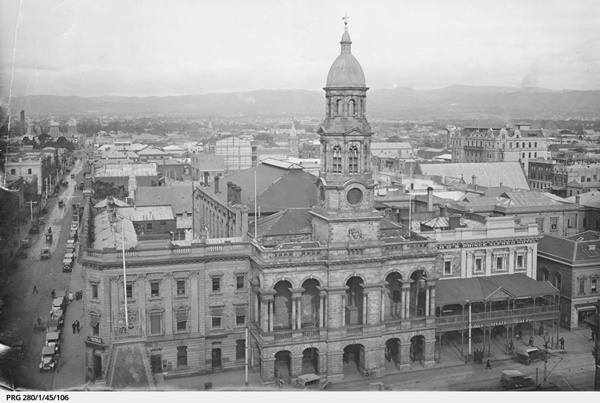The Duel in the City of Adelaide
A duel is something you associate with westerns. Two cowboys pacing it out on a dusty street before turning around, and drawing their guns as quick as possible. And usually the fastest one wins.
So when I found out that there was a duel in my hometown city of Adelaide, South Australia naturally I was intrigued, and had to check it out further.
There was no cowboys, or dusty streets, or tumbleweeds in this duel … (actually the streets may well have been dusty still at this stage), but certainly no cowboys or tumbleweeds. Instead we had politicians!
The two players in this duel are Charles Cameron Kingston, Q.C. & M.P., (1850-1908) and Richard Chaffey Baker, M.L.A. (1841-1911). The scene was the Adelaide Town Hall, on King William Street, Adelaide, and the time was 1.30pm, on Friday, 23 December 1892 … and it all started over name calling!
The Australian Dictionary of Biography sums up the who episode quite succinctly in the following paragraph …
“The most dramatic and colorful episode in Kingston’s political career occurred in 1892. After a prominent conservative member of the Legislative Council, (Sir) Richard Baker, denounced him as a coward, a bully and a disgrace to the legal profession, Kingston responded by describing Baker as ‘false as a friend, treacherous as a colleague, mendacious as a man, and utterly untrustworthy in every relationship of public life’. Kingston did not stop there. He procured a pair of matched pistols, one of which he sent to Baker accompanied by a letter appointing the time for a duel in Victoria Square, Adelaide, on 23 December. Baker wisely informed the police who arrested Kingston shortly after he arrived, holding a loaded revolver. Amidst widespread publicity he was tried and bound over to keep the peace for twelve months. The sentence was still in force when he became premier in June 1893.”
But the best description I’ve found of the whole saga (and there’s literally hundreds on Trove), is one from a Sydney newspaper, The Daily Telegraph, dated Saturday 24 December 1892 …
“Considerable excitement was caused in the city to-day when a rumor gained currency that Mr. C. C. Kingston, Q.C., M.P., had challenged Mr. R. L. Baker, M.L.C., to a duel over a feud which lately has been brought prominently before the public in Parliament and elsewhere. Many rumors are in currency with reference to the affair. As far as can be ascertained the facts are these.”
It goes on …
“A messenger called at Mr. Baker’s office in the city with a package and a letter from Mr. Kingston, which was stated to be “important” by the messenger. Mr. Baker was attending a meeting of the Queensland Mortgage Company, of which he is chairman of directors, and did not receive the communication till 1 o’clock. The letter asked Mr. Baker to meet Mr. Kingston in front of the Town-hall at 1.30 that day. The package accompanying the letter contained a revolver and cartridges. The police were communicated with on the matter; and Detective Kitson and Constable Rea awaited near the square at the time appointed. It is understood that Mr. Baker sent word to Mr. Kingston that he would attend as requested. At the hour named Mr. Kingston, with a six-chambered revolver, fully loaded, went to the square, where he was taken charge of by the officers of the law. It is stated that Mr. Kingston resisted the efforts of the police to secure possession of his revolver, and that Mr. Baker also kept his appointment. Mr. Kingston was detained at the police station for some time, and then released.”
The article goes into what provoked the reaction:
“The trouble arose as follows: Mr. Baker, in a letter to Sir Edwin Smith, which was read in tho Assembly, attacked Mr. M’Pherson and the Trades and Labor Council, whereupon Mr. Kingston severely criticised Mr. Baker’s conduct. Tho latter replied in the Council in a speech in which he stigmatised Mr. Kingston as a “bully and a coward,” and said that the Wheat Rates Committee had found him “guilty of untruth.”
Questions were later asked of Mr Baker as to why he declined taking part in the duel, the following article from the Wagga Wagga Advertiser, on 31 December 1892 explains his reasons
“I had two reasons,” continued Mr. Baker, ” for declining a meeting with Mr. Kingston. One was that, though I was not afraid of him, or of being shot by him, I was afraid of breaking the law and of either being hung for murder or sent to gaol for the rest of my life. Under these circumstances I left the matter entirely in the hands of the Government, in the full belief that the Government would vindicate the law. “
So, yes a duel was scheduled … but no, it never actually happened, thanks to the authorities being notified. But even so, what a sensation it caused. And if you want to read more about it, here’s a link to over 200 articles on Trove about it.
Society of Australian Genealogists …. the Beginnings
Most Aussies who’ve been doing genealogy for a little while will be familiar with the major genealogical societies in each state: QFHS, GSQ, AIGS, GSV, WAGS, GSNT, GST, SAGHS, HAGSOC and SAG. Today’s story focusses on the Society of Australian Genealogists in Sydney, which we commonly refer to as SAG.
While recently browsing on Trove (as you do on cold, almost-winter evenings), I came across the following article which tells of the beginnings of the Society …
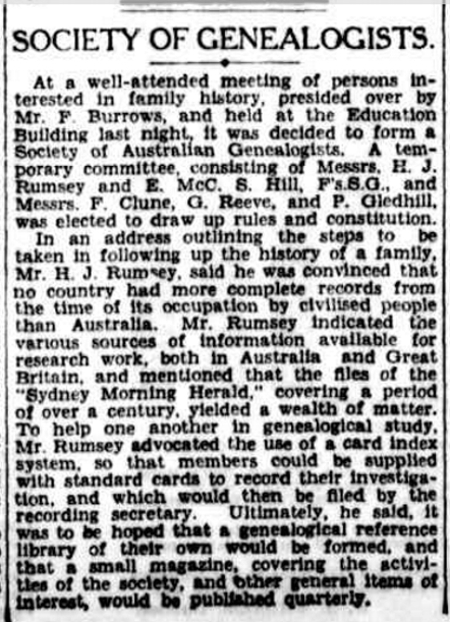
the Sydney Morning Herald, 30 August 1932, p. 8
http://nla.gov.au/nla.news-article16915901
So as you can see the Society of Australian Genealogists was formed way back in 1932. This made me go looking to see when the other state societies were formed, and here’s what I found:
1941 – Genealogical Society of Victoria
1964 – Heraldry & Genealogical Society of Canberra (also now known as Family History ACT)
1973 – South Australian Genealogy & Heraldry Society (also now known as GenealogySA)
1973 – Australian Institute of Genealogical Studies
1978 – Genealogical Society of Queensland
1979 – Queensland Family History Society
1979 – Western Australian Genealogical Society
1980 – Genealogical Society of Tasmania (now known as Tasmanian FHS)
1981 – Genealogical Society of the Northern Territory
A snippet from the above 1932 article states…
“Mr. H. J. Rumsey, said he was convinced that no country had more complete records from the time of its occupation by civilised people than Australia. Mr. Rumsey indicated the various sources of information available for research work, both in Australia and Great Britain … To help one another in genealogical study, Mr. Rumsey advocated the use of a card index system, so that members could be supplied with standard cards to record their investigation. Ultimately, he said, it was to be hoped that a genealogical reference library of their own would be formed, and that a small magazine, covering the activities of the society, and other general items of interest, would be published quarterly.”
Now fast forward two years to June 1934, and we read about the coming “Genealogical Exhibition” which they are holding …
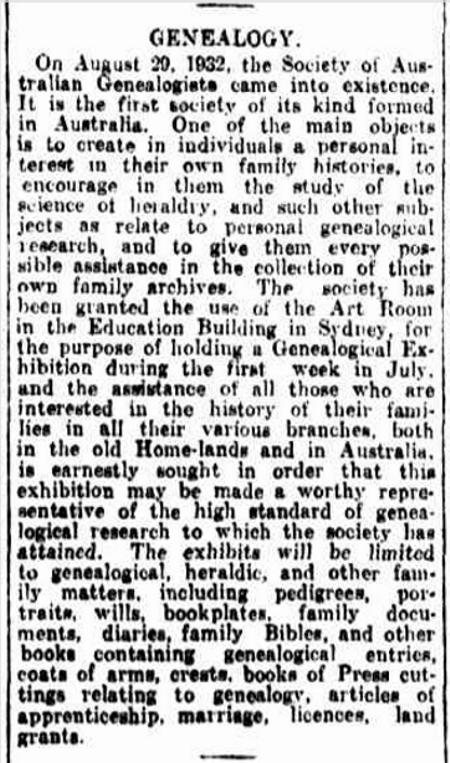
Newcastle Morning Herald and Miners’ Advocate, 14 June 1934, p. 6 http://nla.gov.au/nla.news-article135107397
To quote a portion from the above article it starts off with a little history of the society …
“It is the first society of its kind formed in Australia. One of the main objects is to create in individuals a personal interest in their own family histories, to encourage in them the study of the science of heraldry, and such other subjects as relate to personal genealogical research, and to give them every possible assistance in the collection of their own family archives.”
“… holding a Genealogical Exhibition during the first week in July, and the assistance of all those who are interested in the history of their families … The exhibits will be limited to genealogical, heraldic, and other family matters, including pedigrees, portraits, wills, bookplates, family documents, diaries, family Bibles, and other books containing genealogical entries, coats of arms, crests, books of press cuttings relating to genealogy, articles of apprenticeship, marriage, licences, land grants.”
That would have been fun to attend, don’t you think?
Now fast forward another 83 years to 2017, and the Society of Australian Genealogists is still going strong, with over 4000 members from all round the world, and is totally moving with the times.
SAG have proved themselves to be one of the most innovative groups in Australia. Not only do they have a very spiffy website (www.sag.org.au) , social media accounts (Facebook, Twitter and YouTube), apart from having local meetings online, they also host webinars, have members only section on their site, run a bookshop, and have a number of Special Interest Groups (SIGs) for those who want to focus on something more specific such as writing, DNA, English research or a particular software program, all very valuable ways to keep a society active and members interested.
SAG is also the host society for the next year’s Australasian Congress. So from organising the big exhibition in 1934, to organising Congress in 2018, they’re still going!
I just wanted to say to the Society and their volunteers … you should all be incredibly proud of yourself for the many thousands of people you’ve helped near and far, over the years. And here’s to many more years of helping genealogists find their families! Awesome work guys.
15 April 1912 – The Day the “Titanic” Sank
It was a disaster like no other at that time. The world’s biggest (and self-proclaimed ‘unsinkable’) ship set off from Southampton on 10 April 1912, bound for New York. It was her maiden voyage, and the crowd seeing it off was huge. Little did they know that just 5 days later all onboard would be fighting for their life, with the vast majority not making it.
2.20am, 15 April 1912, just a mere 2 hours and 40 minutes after hitting an iceberg in the Atlantic Ocean, the unthinkable happened to the unsinkable. The Titanic sank.
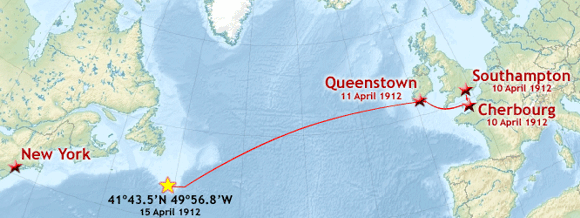
Route of Titanic’s first/last maiden voyage, 10-15 April 1912
(Creative Commons licence, Prioryman)
total capacity: 3547 passengers and crew
total onboard: 2206 passengers and crew
total survived: 703 passengers and crew
That was 105 years ago, and it still has an impact.
The movie below is from British Pathè’s collection, and is just one of the 85,000 old movies they have made freely available. Showing actual footage of the ship, the rescue ships, together with interviews of some survivors, it is chilling.
There’s no doubt that the Titanic has become the stuff of legend.
I remember asking my grandma about it though she wasn’t born at the time, but her older sisters were, and they remembered it, being aged 11 and 12.
So I decided to see what the local South Australian newspapers wrote about it.
The following was the first report of it in South Australia’s “The Advertiser”, was was dated 18 April 1912. Not too bad considering that communication back then wasn’t as instant as we have today. It didn’t make front page like it did in the US or England, but it did make a big article on page 9. The article blow is just a small portion of it.
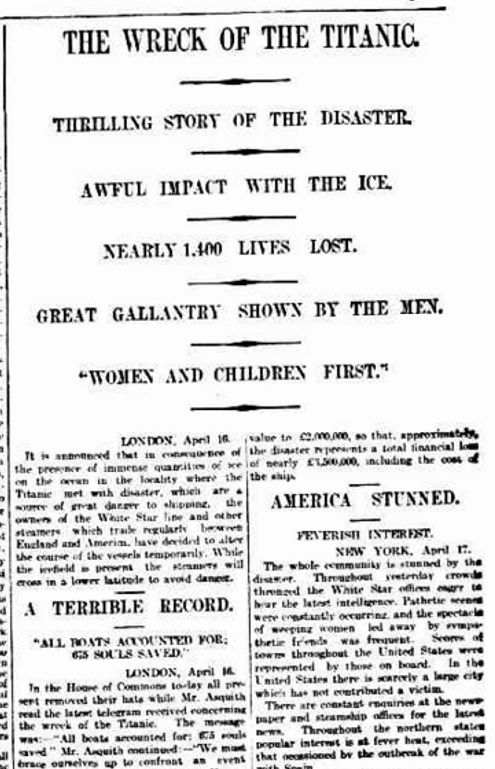
The Wreck of the Titanic, (18 April 1912, The Advertiser , p. 9.) http://nla.gov.au/nla.news-article5336985
And as you would expect, every Australian newspaper ran the story, together with all the reports afterwards. For newspapers just in South Australia, and just in April 1912, Trove has 1000 articles. I’ll admit it, I didn’t read them all.
There’s no doubt this tragedy rocked the world, but something that I was reminded of reading a current news article relating to the 105th Anniversary of this event, was of those who had to go out afterwards and “collect the dead”. We tend to think of the rescuers, but forget about those who went in afterwards.
“As rescue ships approached the ghostly sea where the Titanic plunged into the ocean in the dead of the cold night on April 15, 1912, white specks began to appear in the distance. To onlookers aboard, they looked like “clustering and moving along the waves like a flock of seagulls”. Hundreds of them. All grouped together. The white specks were frozen bodies of the dead, wrapped in the ill-fated steamer’s life belts. For days, great quantities of these bodies, along with doors, pillows, chairs, tables, and scattered remains, floated along the North Atlantic.”
You can read the “Rescue Crews Reveal the Grisly Aftermath of the Titanic Tragedy” here.
So on this day, 105 years on, we remember not only those who lost their life and their families, as well as who were fortunate enough to survive this tragedy, but also those who had the horrific task of “cleaning up” afterwards. Every one of them would have had their life changed from the events that took place on 12 April 1912.
More info on the Titanic:
For more Titanic related old movies from British Pathè click here
100 Facts about the Titanic
Timeline of the Titanic
Wikipedia’s entry for RMS Titanic
Please Note: there are slight discrepancies in the number who died, and the number who survived. One articles says 703 survived, another says 706, another says 705. Another article says 1503 died, another 1517. I’m no professional historian, so I can’t say for sure which is the real figure, but it would be a matter of looking further at how each have calculated their numbers.
Sudden Death at the Railway Station
Some days just don’t go as planned, and 22 June 1869 was certainly one of those day for the Elphick family of Adelaide.
There’s certain words when researching that grab a researchers attention. One being the phrase ‘sudden death’ with another being ‘inquest’. Both of these we terms I came across in the newspapers on Trove, when looking for info on Mr Lonetester’s 3x great grandpa, William Kennard Elphick.
I imagine that Tuesday the 22nd of June 1869 started out as a fairly standard day for the Elphick family of Adelaide. William Kennard Elphick was out and about, and made his way to the Adelaide Railway Station on North Terrace by late afternoon, either to head out or head home. However that’s when tragedy struck.
While walking down the stairs William collapsed, and died …
INQUEST ON MR W.K. ELPHICK
On Wednesday, Mr. T. Ward, J.P., held an inquest at the Adelaide Hospital, for the purpose of ascertaining the cause of the death of William Kennard Elphick. A Jury of 13 having been empanelled, and Mr. J. M. Dowie chosen foreman, the following evidence was taken, after the body had been viewed:— James March Stacy, bootmaker, said yesterday afternoon about 4.20 he was at the Railway Station. Saw a crowd assembled carrying the deceased, whose body he had just seen in the dead-house. Recognised it as that of W. K. Elphick, late of the Burra Mine. Some females bathed his head with cold water. Felt his pulse, and found only one pulsation. Then placed his hand on the heart, which had ceased to beat. Dr. Phillips then came in. Left the deceased in charge of the police, and afterwards communicated with his friends. By a Juror—The cold water was applied whilst he was feeling the pulse of the deceased.James Phillips, surgeon, said he had made a postmortem, examination of the deceased, and on examining the heart found certain portions of it in a greatly dilated state. One part in particular was excessively attenuated. There was fatty degeneration of the structure of the heart, and the arteries which supply the tissues of the heart with blood were ossified. Found also the surface of the brain in a congested state. There was a sudden cessation of the action of the heart from want of power to carry on the circulation. This was undoubtedly the cause of death.
Herbert D. Gouge deposed to being at the Railway Station on Tuesday, and seeing the deceased coming down the terrace towards the station. He came outside, and as witness was about to speak to him, deceased made a plunge forward. The messenger of the Hospital came up and helped witness to carry him into the waiting-room. He did not speak, but groaned heavily once or twice. Dr. Phillips arrived about 10 minutes afterwards. By a Juror—Deceased did not appear to have been walking fast. The Coroner then summed up, and a verdict to the effect that the deceased died from disease of the heart was returned. [The South Australian Advertiser, p. 3. 24 June 1869. http://nla.gov.au/nla.news-article31990554]
It is obvious that William Elphick was someone of note, as every South Australian newspaper that is currently on Trove, has details of his death, and inquest. Mind you having lived and worked not only in Adelaide, but also at Burra, and in Western Australia as well, it’s not really that surprising.
But finding this info was a surprise, and a sad end to one of Mr Lonetester’s emigrating ancestors. William together with his wife arrived on the “Plantar” ship in 1839, after a unbelievable 6 month journey. It took longer than the regular 4 months, as the captain was incompetent as got lost on the way, missing a port, and then had to detour elsewhere to get supplies. Not only that, but the crew mutinied, so a new crew had to be found … and so on. It’s truly stranger than fiction tale, but it happened. Details of the voyage can be found in a shipboard diary that a fellow emigrant wrote.
![Adelaide Railway Station, North Terrace, 1870 [From the State Library of South Australia, Number: B.....]](http://www.lonetester.com/wp-content/uploads/2017/04/Adelaide-Railway-Station-1870-SLSA-580.jpg)
Adelaide Railway Station, North Terrace, South Australia, 1870
[Courtesy of State Library of South Australia, B 69476]

